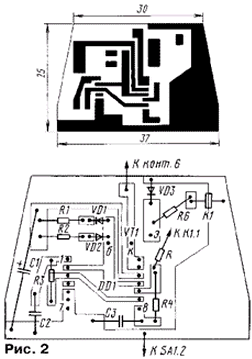
|
|
ENCYCLOPEDIA OF RADIO ELECTRONICS AND ELECTRICAL ENGINEERING Beacon signal shaper. Encyclopedia of radio electronics and electrical engineering
Encyclopedia of radio electronics and electrical engineering / Civil radio communications In some cases, to search for the desired object, the radio station located on it must operate in the beacon mode. This is very useful, for example, when going out into nature. If the car radio is put into the mode in question, then the portable radio, modified in accordance with the recommendations in the magazine mentioned above, can be used to determine the direction to the radio beacon. To transfer the radio station to the radio beacon mode, an automatic device should be installed that would periodically turn it on and at certain intervals give a tone or other sound signal. You can install such a device both inside the body of the radio station and in the microphone headset (tangent). The latter option is more preferable, as it eliminates the need to delve into the radio station itself. The microphone PTT has a simple design, and therefore it is easy to modify, and in extreme cases, repair. Consider the modification of the PTT in relation to the CB radio station "Dragon-SS485". The diagram of the beacon signal generator and radio station control, located in the radio station PTT, is shown in fig. 1. On the element DD1.1, diodes VD1, VD2, resistors R1, R2 and capacitor C1, a generator is assembled that sets the time parameters of the device. The time of the signal, i.e., turning on the radio station for transmission, determines the charging time of the capacitor C1 through the resistor R1, and the interval between the signal (i.e., the receive mode) determines the discharge time of this capacitor through the resistor R2. These intervals can be changed over a wide range by selecting the capacitor C1 and resistors R1, R2.
Turn on the device with switch SA1. Since the capacitor C1 is initially discharged, the operation cycle begins with the transmission mode ("TX"). In this case, a high level enters the base of the transistor VT1, it opens, relay K1 is activated and puts the radio into transmission mode with its contacts. The generator on the DD1.2 element operates at a frequency of several hertz. It controls the operation of the tone generator on the DD1.3 element, which operates at a frequency of about 1 kHz. As a result, a "beepbeep" beacon tone signal is formed, which is fed through the contacts of relay K1.1 to the input of the microphone amplifier. The frequency of the tone signal is set by selecting resistor R4 or capacitor C3, the frequency of "beeps" - by resistor R3 and capacitor C2, and the level of the tone signal - by selecting resistor R5. Thus, if the switch SA1 is in the "Off" position. (it is shown in the diagram), then the radio is operating normally. If it is moved to the "On" position, then it automatically turns on for a while for transmission and delivers tonal bursts. After that, the station switches to receive, and then again works on transmission. For the ratings of the elements indicated in the diagram, the transmission time is approximately 30 and the reception time is about 2 minutes. With a small skill, 30 s is enough to determine the bearing to the radio station. All parts of the device, except for the switch SA1, are placed on a printed circuit board made of one-sided foil fiberglass, a sketch of which is shown in fig. 2. This board is installed in the PTT directly on its printed circuit board (from the side free from conductors) and fixed with glue. Previously, the details of the PTT board are transferred to the side with the conductors - they are placed there without problems. In addition, it is necessary to disconnect the middle terminal of the PTT switch, which is connected to the common wire, by cutting the printed conductor and then restoring the connection of other elements to the common wire. After that, electrical connections are made in accordance with the diagram. Switch SA1 is installed in any convenient place of the PTT.
Transistor VT1 - KT315 with any letter index, all diodes - KD103 with indices A, B, KD104A, capacitor C1 - series K50, K52, non-polar - series KM, K10. Resistors can be C1-4 or MLT, relay K1 - RES60 or REK37 with a response voltage of 5 ... 10 V. The author used a REK37 relay with a winding resistance of 270 ohms and a response voltage of 5 V. Depending on this voltage, resistor R6 should be selected . Switch SA1 - any small-sized two positions and two directions. Setting up the device comes down to setting the desired time and frequency parameters of the generators by selecting the appropriate elements, as mentioned above. Author: I. Nechaev (UA3WIA)
The world's tallest astronomical observatory opened
04.05.2024 Controlling objects using air currents
04.05.2024 Purebred dogs get sick no more often than purebred dogs
03.05.2024
▪ Cells responsible for alcohol cravings discovered ▪ WeWi Sol laptop with solar panel ▪ Schizophrenia-causing cells identified ▪ Explay Atom 3 SIM Smartphone
▪ section of the site Big encyclopedia for children and adults. Selection of articles ▪ article And the thread, twisted three times, will not break soon. Popular expression ▪ article Why do people smoke? Detailed answer ▪ article Legal basis for occupational risk insurance ▪ article Cement for porcelain and faience. Simple recipes and tips ▪ article The number in the envelope. Focus Secret
Home page | Library | Articles | Website map | Site Reviews www.diagram.com.ua |






 Arabic
Arabic Bengali
Bengali Chinese
Chinese English
English French
French German
German Hebrew
Hebrew Hindi
Hindi Italian
Italian Japanese
Japanese Korean
Korean Malay
Malay Polish
Polish Portuguese
Portuguese Spanish
Spanish Turkish
Turkish Ukrainian
Ukrainian Vietnamese
Vietnamese


 Leave your comment on this article:
Leave your comment on this article: